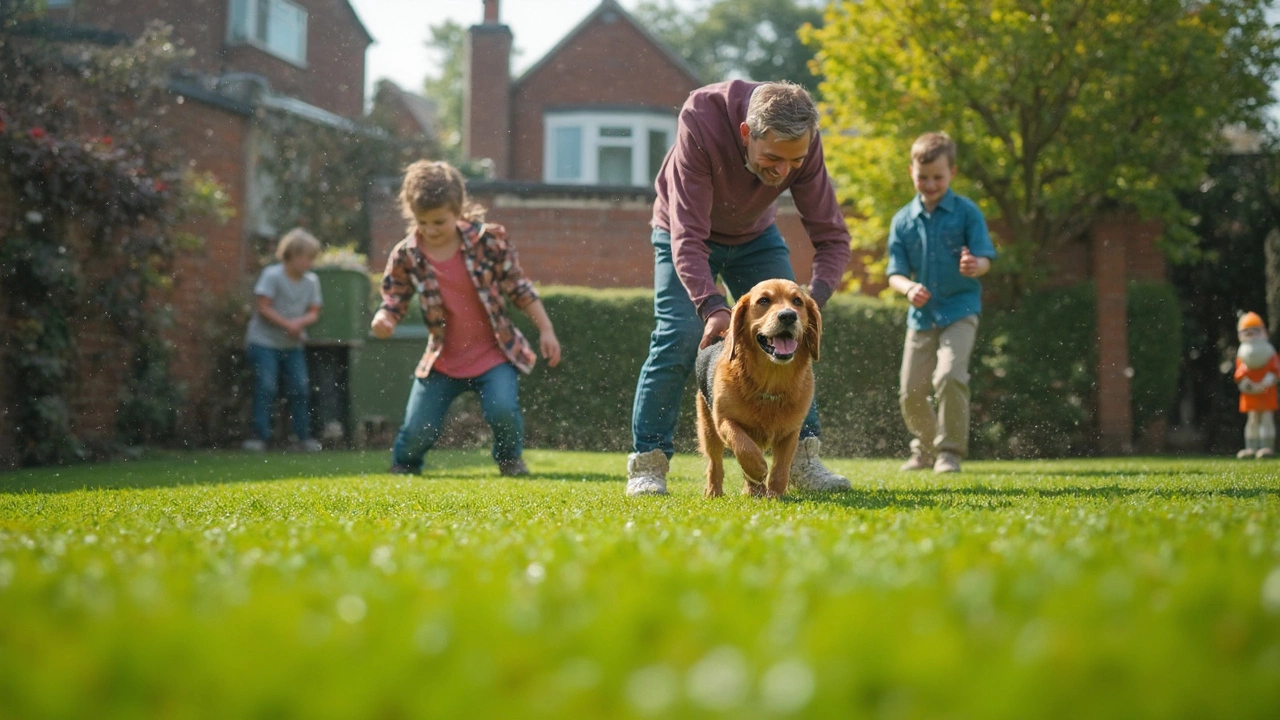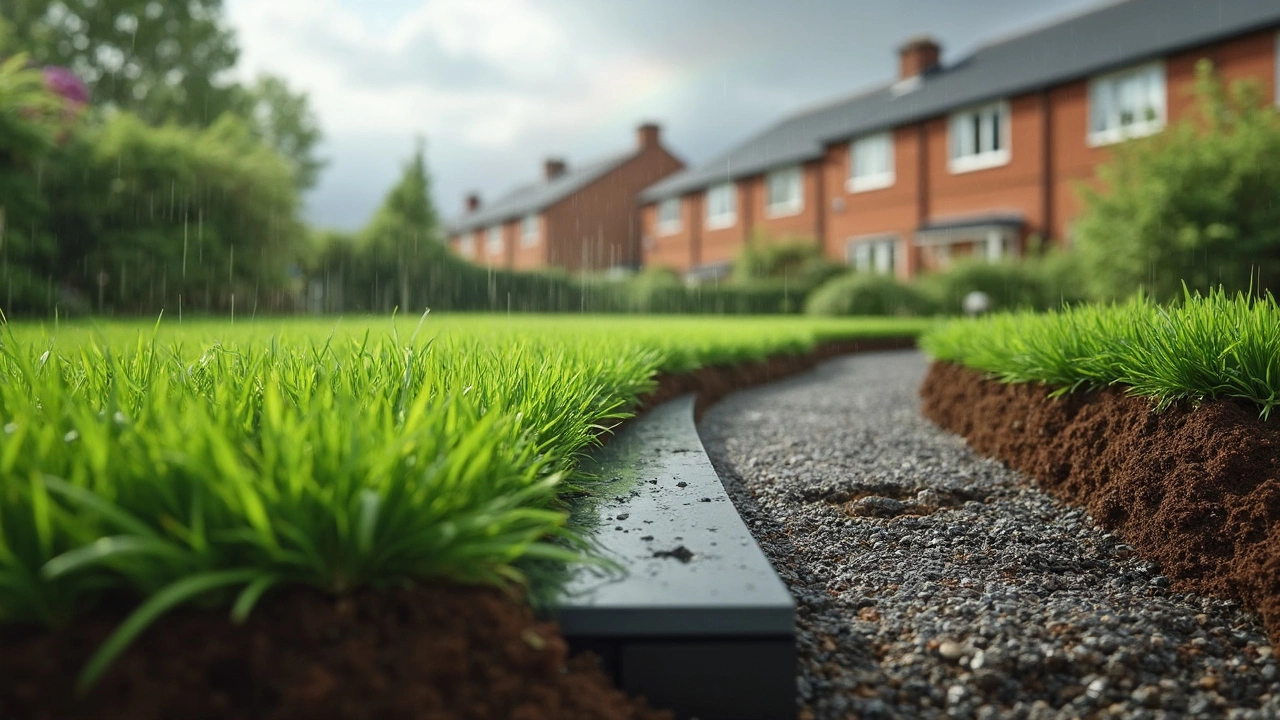Most people think fake grass equals puddles, especially after a big rainstorm. But here’s the real deal: modern artificial grass is designed with built-in drainage. We’re talking tiny holes all over the backing layer, kind of like a colander, so water can slip through instead of pooling on top.
The catch? It’s not just about the turf itself—it’s what’s underneath that matters most. If the base under the grass can’t let water out fast enough, you’ll still end up with soggy patches (and trust me, no one wants to explain that to their kids after a game of tag). It helps to know how your setup works before you buy the first roll you see at the hardware store.
- How Artificial Grass Handles Water
- Common Drainage Problems (and Why They Happen)
- Easy Fixes to Improve Drainage
- Tips to Keep Your Lawn Dry Year-Round
How Artificial Grass Handles Water
One of the most common worries is, “Will my yard turn into a swamp if I put down artificial grass?” Here’s the truth—good turf is made to drain water really well, much better than folks expect. Nearly every roll of quality fake grass has hundreds of drainage holes per square meter punched right through the backing. These aren’t decorative. They let water pass straight through to the base underneath. The average drainage rate for decent turf is 50–60 liters per square meter per minute. Unless you hit a monsoon or you’ve used a bargain-bin brand, that’s more than enough to handle most downpours.
But artificial grass only works if the layers below can keep up. During installation, pros don’t just throw turf on dirt. There’s a process to make sure water can escape:
- First, they dig out some of the existing soil—usually about 2-4 inches deep.
- Next, they fill it in with a compacted base material (typically crushed rock or granite). This layer acts like a giant sponge, letting water move down and away.
- The turf is rolled out on top, and the drainage holes send water through faster than grass ever could.
| Grass Type | Average Drainage Rate (liters/m2/min) |
|---|---|
| Modern artificial grass | 50–60 |
| Older artificial turf | 20–25 |
| Natural grass (good soil) | 10–15 |
It’s easy to see why artificial grass is so popular for backyards, schools, and even dog runs. Water doesn’t just sit on top; it moves through and out, so you don’t have to stress about muddy footprints or dead patches. And if you’re wondering about pet pee, that also drains straight through with a quick rinse. The secret? It’s all about the backing and the right underlay—not just the blades you can see.
Common Drainage Problems (and Why They Happen)
Even the best fake grass can turn into a swamp if the drainage isn’t up to scratch. The most frequent screw-ups? Bad prep work and skipping the right materials. Here’s what actually goes wrong and why.
The main problem is the base layer. If whoever installs your artificial grass just throws it on top of clay soil (which holds water like a clogged bathtub) or skips building a proper drainage base, you’re asking for puddles. Fake grass isn’t magic—it needs somewhere for water to go.
- Artificial grass always has drainage holes, but if the base is packed with regular dirt or clay, water will just sit there. All those tiny holes aren’t much help if there’s nowhere for the water to escape.
- If your yard isn’t graded (sloped) right, spots with dips or low spots become trouble zones for water collection.
- Some installers cheap out with a thin or uneven sub-base, which means water won’t move how it’s supposed to and can get stuck under the turf.
- Heavy use, like kids running back and forth (shoutout to Marlon and Esme), can compact the base over time, making drainage even worse.
Want some hard numbers? Check out this mini table comparing drainage rates:
| Material | Average Drainage Rate (mm/hour) |
|---|---|
| Proper aggregate sub-base | >200 |
| Compacted native clay | <10 |
| Unprepared garden soil | 10-30 |
So, if your installer skips the gravel base or just throws turf on dirt, water will hang around for ages. Not exactly the "maintenance-free" yard you were promised, right?
One more curveball: gutter downspouts dumping water right onto your turf can overwhelm any drainage setup, no matter how well-installed. Always keep an eye on where the water is coming from, not just where it ends up.

Easy Fixes to Improve Drainage
Struggling with water pooling on your fake grass isn't fun, especially when you’re hoping for a low-maintenance lawn. Fortunately, most drainage problems with artificial grass can be sorted with some simple tweaks—no pros needed for the basics.
First up: Check the base layer. Artificial grass needs a stable, free-draining foundation. If your lawn sits on clay or super compacted soil, water won’t drain well, no matter how many holes are in the turf. In these cases, digging out a few extra inches and adding a sub-base of crushed stone or limestone chippings (about 2–4 inches deep) makes a massive difference. This base gives rainwater space to flow away under the grass.
If you've already installed the turf and still notice puddles, you can poke a few extra holes in waterlogged spots with a garden fork. It sounds basic, but giving water a path down helps a lot, especially after a heavy storm.
For serious soggy spots or places with lots of runoff—maybe near downspouts or at the bottom of a hill—you might need to add a perforated drain pipe (French drain). This type of pipe is wrapped in fabric and laid under the base layer, then covered back up. It routes excess water away before it becomes a problem.
- Use a vibrating plate compactor when setting your base: It squashes air pockets that could hold water and helps drainage.
- After installing, regularly brush up your turf: This keeps those drainage holes clear of fallen leaves, mud, or pet hair (Snowball the cat, looking at you).
- Keep gutters and downspouts aimed away from the grass, or connect them to drains outside your lawn space.
Avoid using sand alone for your base under artificial grass. Sand can get super compacted and actually slow drainage down after a while. Better to go for crushed rock or a blend made just for this job.
Tips to Keep Your Lawn Dry Year-Round
Keeping your artificial grass dry and puddle-free is all about what you do before and after installation. There’s no need to stress if you follow a few practical steps—most people don’t realize how much the prep work matters, but it makes a huge difference for drainage in the long run.
- Start with a Good Base: Use a compacted layer of crushed granite or limestone beneath the turf. Avoid regular soil. These help water drain quickly instead of getting trapped. Ask for 3-4 inches thick—this is the sweet spot for homes dealing with lots of rain.
- Check Slope and Grading: The yard should have a gentle slope, usually about a 2% grade, pointing away from your house. Flats and dips mean water sticks around. This step is super important for drainage and gets skipped way too often.
- Clean the Turf Regularly: Leaves, mud, and pet hair can clog those tiny holes in the grass backing over time. Grab a stiff broom after storms or when Snowball decides to nap in the sun. Keep it clear and water moves smoothly through.
- Add Perimeter Drains If Needed: For yards that stay wet or have heavy clay soil, putting in a French drain (a pipe buried underground along problem spots) is worth the effort. It can channel water out fast, making artificial grass more reliable even during rainy seasons.
- Punch Extra Holes (As a Last Resort): If certain areas still stay soggy, you can add drainage holes yourself with a drill. Just be careful—don’t make too many, or you’ll mess up the structure.
No matter where you live, these tricks help your lawn handle whatever nature throws at it. Honestly, it’s easier than you think to avoid those muddy disasters, and you’ll spend way more time enjoying your yard (instead of sweeping water off it).
